EHS Software Evolves to Enable Operation 2030
Explore how the EHS software market enables an Operation 2030 strategy, overcoming today’s workforce challenges to deliver more sustainable...
Connecting the workforce to the right data at the right time, with the right context, enables manufacturers to unlock a whole new level of operational performance. Unfortunately, the technology landscape for most industrial organizations lacks the functionality consumers have become accustomed to in their daily lives. Affordable devices, applications, and technology provide access to seemingly unlimited information, products, and services for our personal lives – sometimes before you even know you need them.
The evolving manufacturing architecture is a core enabler bridging data acquisition and processes to eliminate silos and improve decision-making across the organization. While there was a strong focus on moving to the Cloud, manufacturers have significantly increased Edge capabilities as device affordability has improved. Industrial organizations can better capture the full value of new digital technology by leveraging On-Premise, Edge, and Cloud capabilities to transform operations.
Connected Frontline Operations, pictured below, conceptualizes the evolving manufacturing architecture and how CFW solutions are key to future-proof frontlines.
This blog helps Global Heads of Operations achieve the ultimate goal of connecting anyone, anything, anytime, and anywhere. By learning what capabilities Industrial Transformation (IX) Leaders implement within the plant, at the enterprise, and outside the firewall, you can build a connected manufacturing strategy to enable and empower the workforce with data-driven insights.
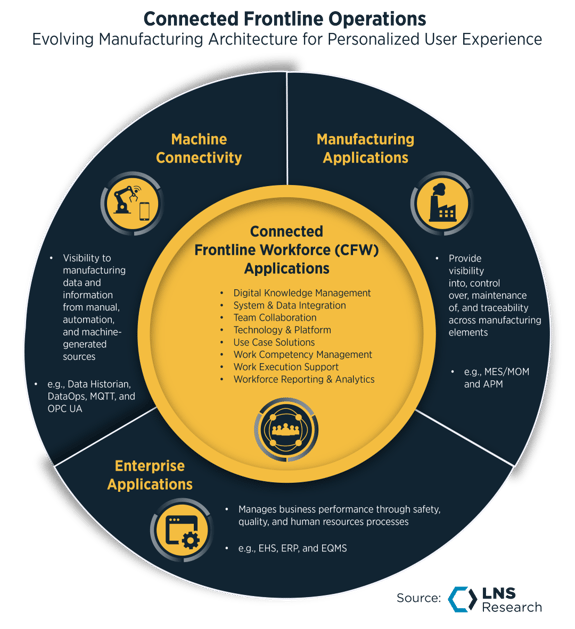
Quite often, manufacturers are challenged with a plethora of legacy solutions and a hodge-podge of communication protocols. Turning information into insight can be difficult when the data is collected and stored across solutions not designed to connect readily. This manufacturing reality and increased adoption of innovative technology have required industrial organizations to reassess Operational Architectures to fill system gaps and rearchitect business processes.
 Moving away from fragmented legacy systems and siloed data sources removes obstacles and facilitates operational visibility, collaboration, process execution, and continuous improvement. Growing maturity across Industrial Internet of Things (IIoT) technology enables connecting things, devices, equipment, and people in previously impossible or too costly ways. Significant headway has been made in recent years, interconnecting people, processes, and assets within a facility, across the enterprise, and throughout the value chain.
Moving away from fragmented legacy systems and siloed data sources removes obstacles and facilitates operational visibility, collaboration, process execution, and continuous improvement. Growing maturity across Industrial Internet of Things (IIoT) technology enables connecting things, devices, equipment, and people in previously impossible or too costly ways. Significant headway has been made in recent years, interconnecting people, processes, and assets within a facility, across the enterprise, and throughout the value chain.
When asked about the effectiveness of DCS, MES, MOM, HMI/SCADA, and APM/EAM systems, LNS Research found:
24% of industrials have a variety of legacy applications and systems in place.
48% of Followers have a mix of legacy and new multi-tenant/multi-cloud enabled systems supporting a few best-in-class applications.
57% of Leaders have moved to best-in-class applications on next-gen multi-tenant/multi-cloud enabled systems.
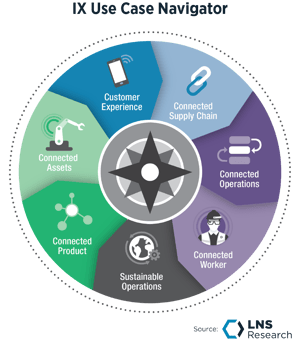 Projected retirements of Baby Boomers and Gen X employees, currently half of today's workforce, make it more critical than ever for companies to invest in ways that tap into legacy systems (Connected Assets) and leverage institutional knowledge (Connected Workers) to support the entire organization (Connected Operations). IX programs should focus on smart-connected ways across many use cases to turn information and data into valuable insight. End users developing a strategy that enables the workforce instead of just providing access to information should reference the LNS Research IX Reference Architecture, which provides a framework by categorizing technology capabilities across the IIoT environment.
Projected retirements of Baby Boomers and Gen X employees, currently half of today's workforce, make it more critical than ever for companies to invest in ways that tap into legacy systems (Connected Assets) and leverage institutional knowledge (Connected Workers) to support the entire organization (Connected Operations). IX programs should focus on smart-connected ways across many use cases to turn information and data into valuable insight. End users developing a strategy that enables the workforce instead of just providing access to information should reference the LNS Research IX Reference Architecture, which provides a framework by categorizing technology capabilities across the IIoT environment.
It's not uncommon to have multiple applications across a business unit and within the same plant. Existing systems are often too tightly linked to specific equipment and ignore other critical data. Many industrial organizations first set their sights on creating data lakes to collect the data in a central repository to solve communication issues between systems.
Unfortunately, while trying to solve one problem, data lakes seemed to look and smell a lot like data swamps, with data often missing the context needed to capitalize efforts. Additionally, solutions are historically designed for a business purpose and not for the user experience. In a perfect world, the needs of both would be met.
Manufacturing is recognizing the value of persona-based user interfaces given the myriad of legacy systems, next-gen systems, and other data sources across the data hub. Connected Frontline Workforce (CFW) applications create a user experience environment that provides the workforce with personalized guidance, support, and near real-time feedback. CFW solutions eliminate the noise from the industrial data architecture for the worker, thus improving outcomes and accelerating time to value.
So, what are IX Leaders doing differently to connect anyone, anything, anytime, and anywhere? Quite simply, they are evolving the traditional manufacturing data practices.
Cross-functional Collaboration and Convergence
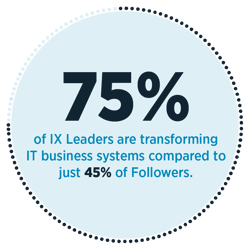 To accelerate the shift from collection to capital, 63% of Leaders implement a Data Governance Council comprised of IT, OT, and stakeholders across the business. Leaders were also almost 2.5 times more likely to fully converge IT and OT teams when engaging in IX and supporting legacy systems than Followers. Going even further, 75% of Leaders are updating, upgrading, and/or re-architecting IT business systems as part of the overall IX program. Focusing on user persona is a significant enabler of connected manufacturing.
To accelerate the shift from collection to capital, 63% of Leaders implement a Data Governance Council comprised of IT, OT, and stakeholders across the business. Leaders were also almost 2.5 times more likely to fully converge IT and OT teams when engaging in IX and supporting legacy systems than Followers. Going even further, 75% of Leaders are updating, upgrading, and/or re-architecting IT business systems as part of the overall IX program. Focusing on user persona is a significant enabler of connected manufacturing.
Connectivity and Capability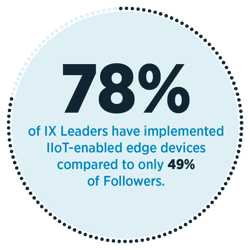
Leaders have been found to implement connectivity/hardware technology two times more than Followers. Investments include device connectivity and sensors, IIoT-enabled edge devices, and smart wearables, with 45% of Leaders planning on adding more sensors to assets and production processes to collect more data. Leaders also show differentiation with capabilities that support On-Premise (e.g., data historians), Edge (e.g., MES), private Cloud (e.g., EQMS), and public Cloud (e.g., warehouse management) deployments providing data collection, storage, computing, and distribution capabilities. A Connected Frontline Workforce and connected manufacturing are becoming two peas in a pod, creating a North Star from noise.
Creating the Employer of Choice Reputation with Technology
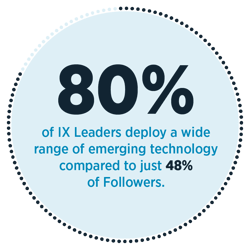 Being perceived as an Employer of Choice is a central focus for Leaders, who are two times more likely than Followers to see it as the top driver for IX programs. Future of Industrial Work research shows industrial organizations better attract and retain employees by proactively deploying digital technology to support and connect the workforce. Eighty percent of Leaders are in the pilot stages or beyond in deploying a wide range of emerging technology, and 50% are improving training programs for the technology. Advanced Industrial Analytics can connect the dots and augment the employee experience by providing data-driven insights on where and when it is needed most.
Being perceived as an Employer of Choice is a central focus for Leaders, who are two times more likely than Followers to see it as the top driver for IX programs. Future of Industrial Work research shows industrial organizations better attract and retain employees by proactively deploying digital technology to support and connect the workforce. Eighty percent of Leaders are in the pilot stages or beyond in deploying a wide range of emerging technology, and 50% are improving training programs for the technology. Advanced Industrial Analytics can connect the dots and augment the employee experience by providing data-driven insights on where and when it is needed most.
Leaders are designing an IIoT environment that connects workers with computing capabilities closer to the source rather than being limited to corporate data centers. Data collection from and around equipment, machines, processes, and people will continue to be increasingly more cost-effective. While the availability and affordability of technology will continue to improve, manufacturers must be ready to capitalize more on the collected data.

The next-gen workforce expects a more customizable and personalized user experience. Ultimately, the employee is looking for more meaning and purpose in work with data-driven insight, in context, made possible by implementing capabilities within the plant, at the enterprise, and outside the firewall.
Industrial organizations can create meaningful work and capture business value by connecting anyone, anything, anytime, and anywhere with the following in mind:
Focus on quality over quantity. The goal shouldn't be to generate and collect as much data as possible for a potential future need. Corporations should first assess the data currently collected due to regulatory or industry requirements. What insights are being produced from the data? Start with who could be positively impacted most to understand how existing data can be made more valuable.
Emphasize broad use cases and enterprise scaling. Companies still find themselves having spent precious time and resources on new, exciting technology with very little to show for it. Transformation initiatives must focus on implementing technology applicable across a set of use cases. Has the team developed a way to track tangible and intangible benefits? Ensure you begin with the end in mind, recognizing that enterprise-wide scale is how Leaders differentiate IX success.
Collect user experience to improve the technology landscape. Recognizing the importance of technology to next-gen employees is crucial for manufacturers to survive the escalating workforce crisis. Companies focusing on user experience and persona needs when it comes to systems and solutions improve the likelihood of becoming a desirable Employer of Choice. Is the organization ready for the digital natives who will dominate the workforce by 2031? Manufacturers should implement ways to proactively monitor whether available technology is being used and collect user feedback to improve the technology approach and employee experience, maximizing business value.
Aim for interoperability from the inside and outside. Manufacturing has learned the importance of communication the hard way regarding systems and solutions. The challenges faced today have been created by decades of focusing too narrowly. Legacy systems were often designed to create, rather than eliminate, silos, and communication was limited intentionally. Is the company focused on ensuring internal and external systems are interoperable? Connecting across the entire value chain, including suppliers and end users, will be key to achieving a competitive advantage by identifying problems before they impact operational performance.
As a member-level partner of LNS Research, you will receive our expert and proven Advisory Services. These exclusive benefits give your team:
Let us help you with key decisions based on our solid research methodology and vast industrial experience.
BOOK A STRATEGY CALLSiemens Acquires Camstar: Better Realizing Innovation for 3 Vertical Industries
The Definitive Guide to Manufacturing Acronyms
Five Ways Industrial AI is Shaking Up Manufacturing (and Who’s Doing It)
Top 6 Challenges in Electronics Manufacturing
What Is Industrial DataOps & Why Does Every Manufacturer Need It?
Explore how the EHS software market enables an Operation 2030 strategy, overcoming today’s workforce challenges to deliver more sustainable...
Connected Frontline Workforce (CFW) technology is a proven enabler in today’s operations environment. Learn how to accelerate your CFW Value Curve...
It’s time the frontline workforce is seen as one of the most critical industrial assets. Discover key insights on future-proofing your frontline...
The Industrial Transformation and Operational Excellence Blog is an informal environment for our analysts to share thoughts and insights on a range of technology and business topics.